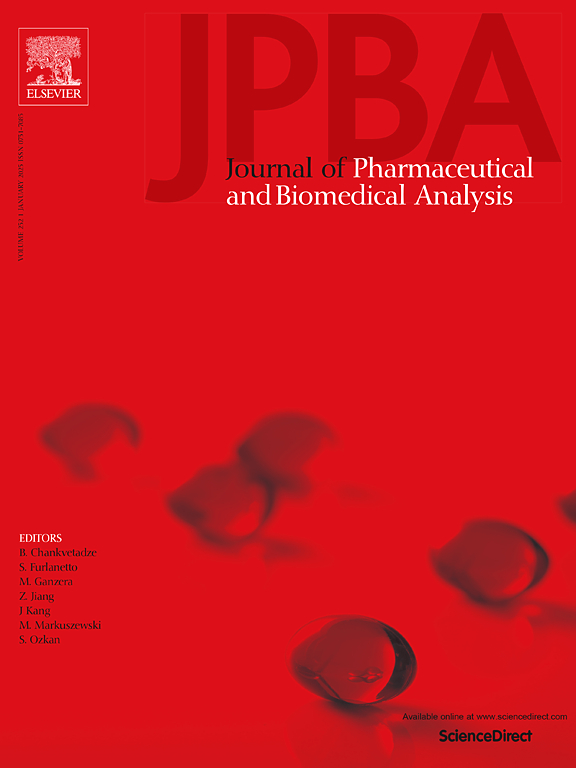Joint multi-technology applications for etablishing quality evaluation model of Coptidis Rhizoma
IF 3.1
3区 医学
Q2 CHEMISTRY, ANALYTICAL
Journal of pharmaceutical and biomedical analysis
Pub Date : 2025-05-14
DOI:10.1016/j.jpba.2025.116952
引用次数: 0
Abstract
Based on the pharmacodynamic components of Coptidis Rhizoma (CR) against oral squamous cell carcinoma (OSCC), the combination of chromatographic and spectroscopic techniques was used to achieve the rapid detection of CR quality, which provided a reference for the implementation of the quality detection method of CR oriented to the clinical efficacy. Firstly, the pharmacodynamic components of CR in the treatment of OSCC were studied by means of network pharmacology and molecular docking technology, and the pharmacodynamic components were screened and verified in vitro to screen out the key active components. Subsequently, the contents of key active ingredients of CR from different origins were detected and quantitative analysis models were established by a combination of high performance liquid chromatography (HPLC) and near infrared spectroscopy (NIR) techniques. The results showed that berberine and palmatine in CR had strong curative effect in the treatment of OSCC. Using berberine and palmatine as the key active ingredients, the content of the key active ingredients obtained by HPLC was used as the reference, and the prediction model of berberine and palmatine content was constructed by combining the NIR and partial least squares regression algorithm, and the model obtained a better prediction result with the correlation coefficients of R2p of 0.9704 and 0.8793, respectively. This study screened the index components of CR against OSCC, and also demonstrated that NIR combined with chemometrics had the ability to quantitatively analyse the content of the components quickly, conveniently and accurately. This study is expected to be used for the simultaneous rapid detection of the anti-OSCC components in CR, which will provide a reference for the quality evaluation of CR raw herbs oriented to clinical efficacy.
联合多技术应用建立黄连质量评价模型
基于黄连(Coptidis Rhizoma, CR)抗口腔鳞状细胞癌(oral squamous cell carcinoma, OSCC)的药效学成分,采用色谱与光谱相结合的方法实现了CR质量的快速检测,为实施面向临床疗效的CR质量检测方法提供了参考。首先,通过网络药理学和分子对接技术对CR治疗OSCC的药效成分进行研究,并对药效成分进行体外筛选和验证,筛选出关键活性成分。随后,采用高效液相色谱(HPLC)和近红外光谱(NIR)相结合的方法,对不同产地川芎主要有效成分含量进行检测,并建立定量分析模型。结果表明:CR中小檗碱、巴马汀治疗OSCC有较好的疗效。以小檗碱和巴马汀为关键有效成分,以HPLC法测得的关键有效成分含量为参考,结合近红外和偏最小二乘回归算法构建小檗碱和巴马汀含量预测模型,模型的相关系数R2p分别为0.9704和0.8793,预测结果较好。本研究筛选了CR对OSCC的指标成分,也证明了近红外结合化学计量学能够快速、方便、准确地定量分析各成分的含量。本研究有望用于CR中抗oscc成分的同时快速检测,为面向临床疗效的CR原料药质量评价提供参考。
本文章由计算机程序翻译,如有差异,请以英文原文为准。
求助全文
约1分钟内获得全文
求助全文
来源期刊
CiteScore
6.70
自引率
5.90%
发文量
588
审稿时长
37 days
期刊介绍:
This journal is an international medium directed towards the needs of academic, clinical, government and industrial analysis by publishing original research reports and critical reviews on pharmaceutical and biomedical analysis. It covers the interdisciplinary aspects of analysis in the pharmaceutical, biomedical and clinical sciences, including developments in analytical methodology, instrumentation, computation and interpretation. Submissions on novel applications focusing on drug purity and stability studies, pharmacokinetics, therapeutic monitoring, metabolic profiling; drug-related aspects of analytical biochemistry and forensic toxicology; quality assurance in the pharmaceutical industry are also welcome.
Studies from areas of well established and poorly selective methods, such as UV-VIS spectrophotometry (including derivative and multi-wavelength measurements), basic electroanalytical (potentiometric, polarographic and voltammetric) methods, fluorimetry, flow-injection analysis, etc. are accepted for publication in exceptional cases only, if a unique and substantial advantage over presently known systems is demonstrated. The same applies to the assay of simple drug formulations by any kind of methods and the determination of drugs in biological samples based merely on spiked samples. Drug purity/stability studies should contain information on the structure elucidation of the impurities/degradants.

 求助内容:
求助内容: 应助结果提醒方式:
应助结果提醒方式:


